Random Fiber Grating Characterization Based on OFDR and Transfer Matrix Method
Abstract
1. Introduction
2. Experimental Characterization of RFG
2.1. Reflectivity Characterization in Position Domain
2.2. Local Spectral Response Characterization
2.3. Linewidth Scaling Behavior
3. Theoretical Simulation of RFG
4. Conclusions
Author Contributions
Funding
Conflicts of Interest
References
- Abdullina, S.; Skvortsov, M.; Vlasov, A.; Podivilov, E.; Babin, S. Coherent Raman lasing in a short polarization-maintaining fiber with a random fiber Bragg grating array. Laser Phys. Lett. 2019, 16, 105001. [Google Scholar] [CrossRef]
- Chiavaioli, F.; Baldini, F.; Trono, C. Manufacturing and spectral features of different types of long period fiber gratings: Phase-shifted, turn-around point, internally tilted, and pseudo-random. Fibers 2017, 5, 29. [Google Scholar] [CrossRef]
- Lizárraga, N.; Puente, N.; Chaikina, E.; Leskova, T.; Méndez, E. Single-mode Er-doped fiber random laser with distributed Bragg grating feedback. Opt. Express 2009, 17, 395–404. [Google Scholar] [CrossRef] [PubMed]
- Gagné, M.; Kashyap, R. Demonstration of a 3 mW threshold Er-doped random fiber laser based on a unique fiber Bragg grating. Opt. Express 2009, 17, 19067–19074. [Google Scholar] [CrossRef] [PubMed]
- Lu, C.; Cui, J.; Cui, Y. Reflection spectra of fiber Bragg gratings with random fluctuations. Opt. Fiber Technol. 2008, 14, 97–101. [Google Scholar] [CrossRef]
- Xu, Y.; Lu, P.; Gao, S.; Xiang, D.; Lu, P.; Mihailov, S.; Bao, X. Optical fiber random grating-based multiparameter sensor. Opt. Lett. 2015, 40, 5514–5517. [Google Scholar] [CrossRef]
- Monet, F.; Loranger, S.; Lambin-Iezzi, V.; Drouin, A.; Kadoury, S.; Kashyap, R. The ROGUE: A novel, noise-generated random grating. Opt. Express 2019, 27, 13895–13909. [Google Scholar] [CrossRef] [PubMed]
- Lu, P.; Mihailov, S.; Coulas, D.; Ding, H.; Bao, X. Low Loss Random Fiber Gratings Made with a fs-IR Laser for Distributed Fiber Sensing. J. Light. Technol. 2019, 37, 4697–4702. [Google Scholar] [CrossRef]
- Li, Y.; Lu, P.; Bao, X.; Ou, Z. Random spaced index modulation for a narrow linewidth tunable fiber laser with low intensity noise. Opt. Lett. 2014, 39, 2294–2297. [Google Scholar] [CrossRef] [PubMed]
- Zhang, L.; Xu, Y.; Lu, P.; Mihailov, S.; Chen, L.; Bao, X. Multi-Wavelength Brillouin Random Fiber Laser via Distributed Feedback from a Random Fiber Grating. J. Light. Technol. 2018, 36, 2122–2128. [Google Scholar] [CrossRef]
- Gagné, M.; Kashyap, R. Random fiber Bragg grating Raman fiber laser. Opt. Lett. 2014, 39, 2755–2758. [Google Scholar] [CrossRef] [PubMed]
- Lima, B.C.; Gomes, A.S.L.; Pincheira, P.I.R.; Moura, A.L.; Gagné, M.; Raposo, E.P.; de Araújo, C.B.; Kashyap, R. Observation of Lévy statistics in one-dimensional erbium-based random fiber laser. J. Opt. Soc. Am. B 2017, 34, 293. [Google Scholar] [CrossRef]
- Xu, Y.; Gao, S.; Lu, P.; Mihailov, S.; Chen, L.; Bao, X. Low-noise Brillouin random fiber laser with a random grating-based resonator. Opt. Lett. 2016, 41, 3197–3200. [Google Scholar] [CrossRef]
- Zhou, Z.; Lu, P.; Zhang, L.; Mihailov, S.; Chen, L.; Bao, X. Thermal and acoustic noise insensitive Brillouin random fiber laser based on polarization-maintaining random fiber grating. Opt. Lett. 2019, 44, 4195–4198. [Google Scholar] [CrossRef]
- Xu, Y.; Zhang, L.; Gao, S.; Lu, P.; Mihailov, S.; Bao, X. Highly sensitive fiber random-grating-based random laser sensor for ultrasound detection. Opt. Lett. 2017, 42, 1353–1356. [Google Scholar] [CrossRef]
- Miao, S.; Zhang, W.; Song, Y.; Huang, W. High-resolution random fiber laser acoustic emission sensor. Opt. Express 2020, 28, 12699–12708. [Google Scholar] [CrossRef]
- Soller, B.J.; Gifford, D.K.; Wolfe, M.S.; Froggatt, M.E. High resolution optical frequency domain reflectometry for characterization of components and assemblies. Opt. Express 2005, 13, 666–674. [Google Scholar] [CrossRef] [PubMed]
- Shapira, O.; Fischer, B. Localization of light in a random-grating array in a single-mode fiber. JOSA B 2005, 22, 2542–2552. [Google Scholar] [CrossRef]
- Berry, M.; Klein, S. Transparent mirrors: Rays, waves and localization. Eur. J. Phys. 1997, 18, 222. [Google Scholar] [CrossRef]
- Jordan, T.; Partridge, J.; Roberts, N. Disordered animal multilayer reflectors and the localization of light. J. R. Soc. Interface 2014, 11, 20140948. [Google Scholar] [CrossRef][Green Version]
- Wang, X.; Li, W.; Chen, L.; Bao, X. Thermal and mechanical properties of tapered single mode fiber measured by OFDR and its application for high-sensitivity force measurement. Opt. Express 2012, 20, 14779–14788. [Google Scholar] [CrossRef] [PubMed]
- Zurek, W.H. Complexity, Entropy and the Physics of Information; CRC Press: Boca Raton, FL, USA, 2018. [Google Scholar]
- Kashyap, R. Fiber Bragg Gratings; Academic Press: Cambridge, MA, USA, 2009. [Google Scholar]
- Mafi, A. Anderson localization in a partially random Bragg grating and a conserved area theorem. Opt. Lett. 2015, 40, 3603–3606. [Google Scholar] [CrossRef] [PubMed][Green Version]
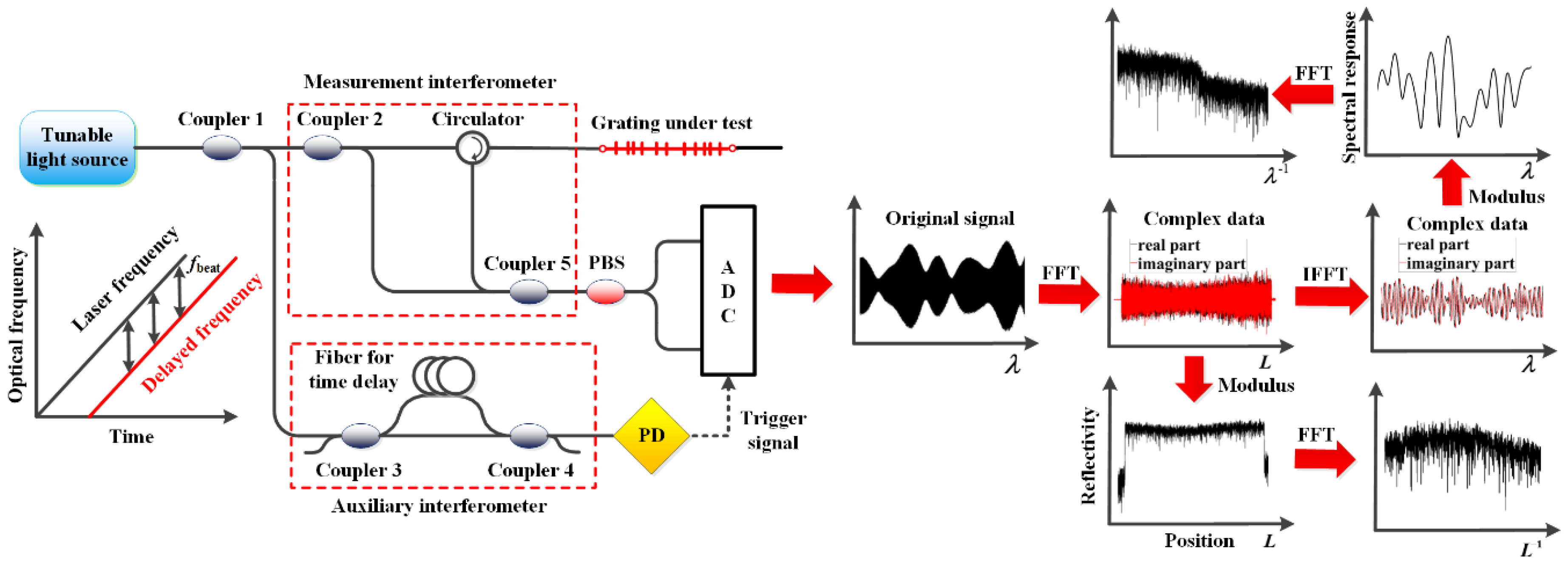

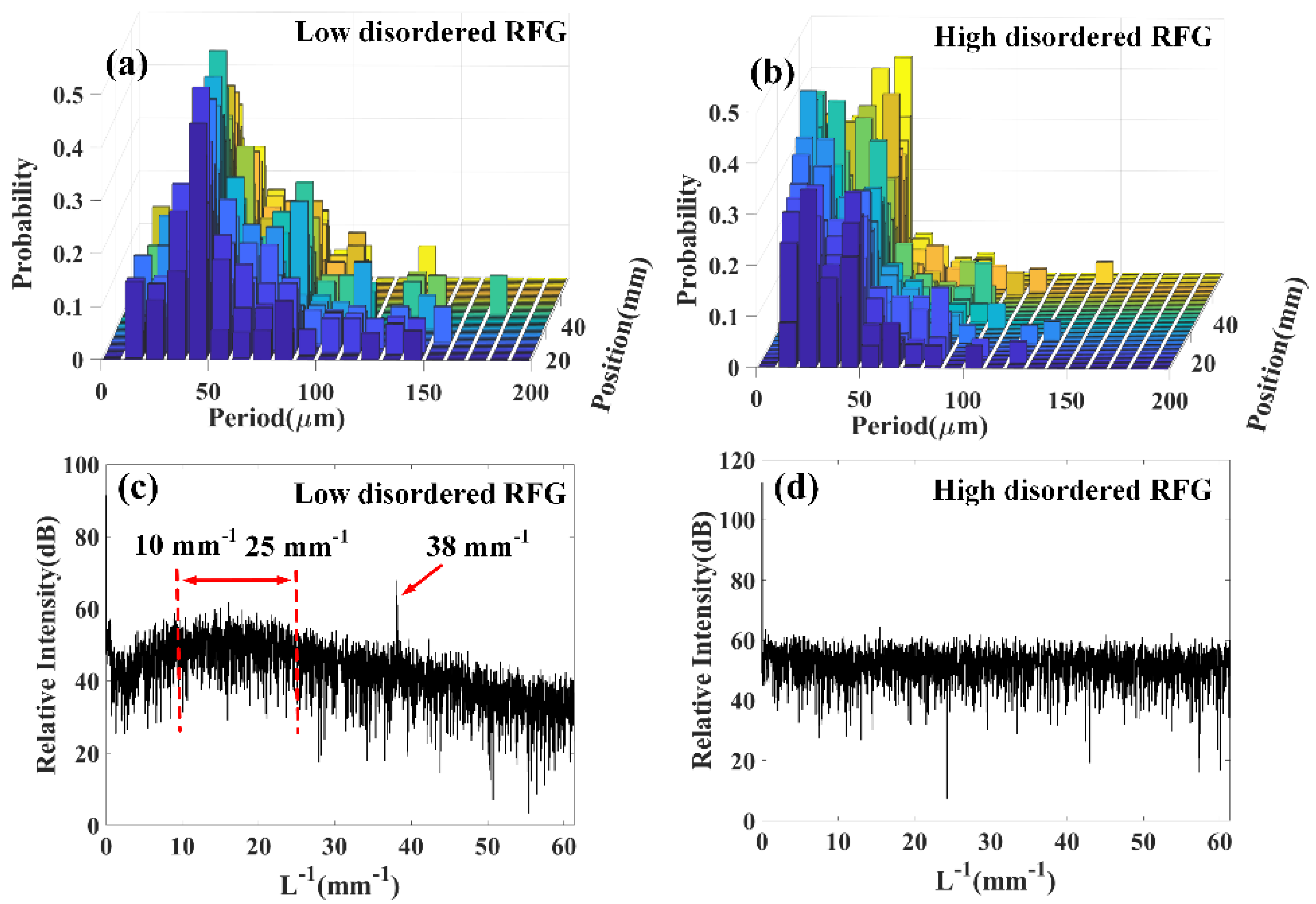

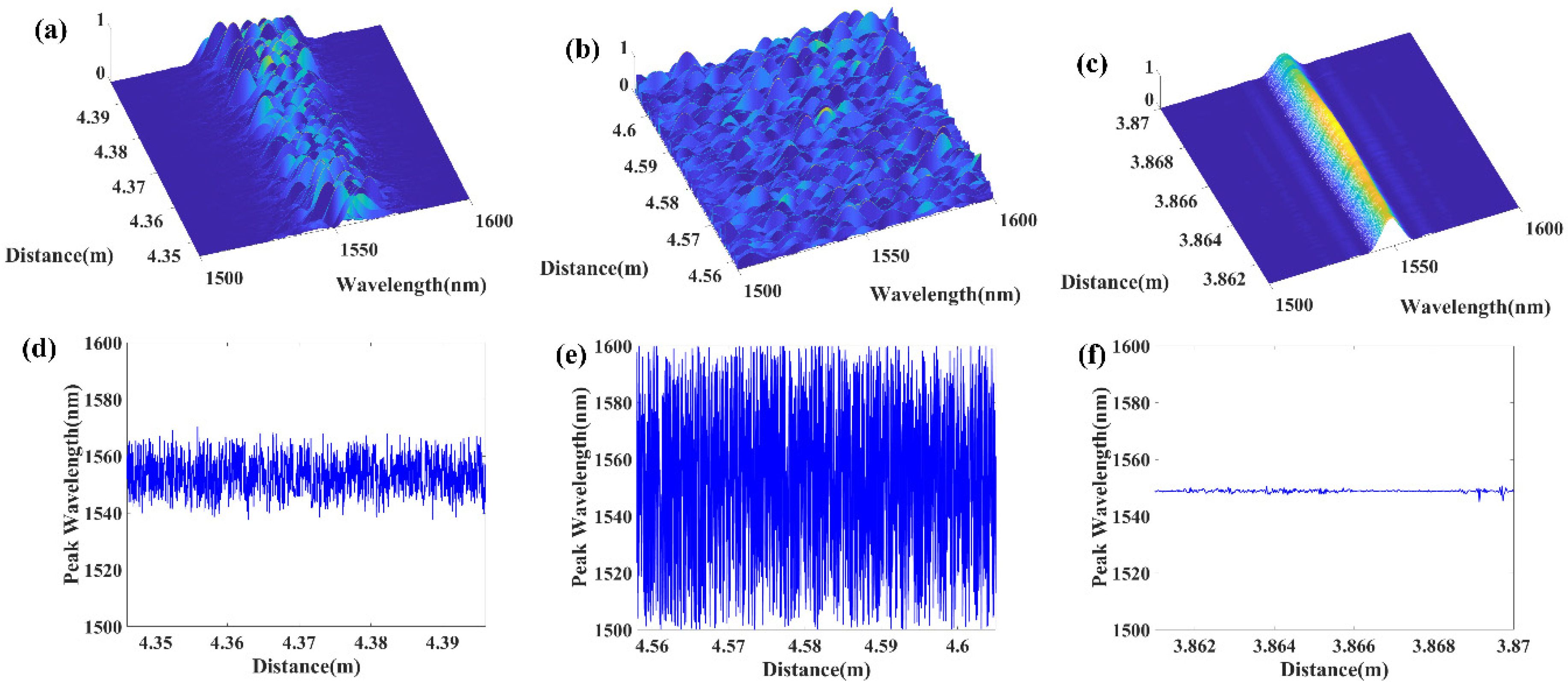

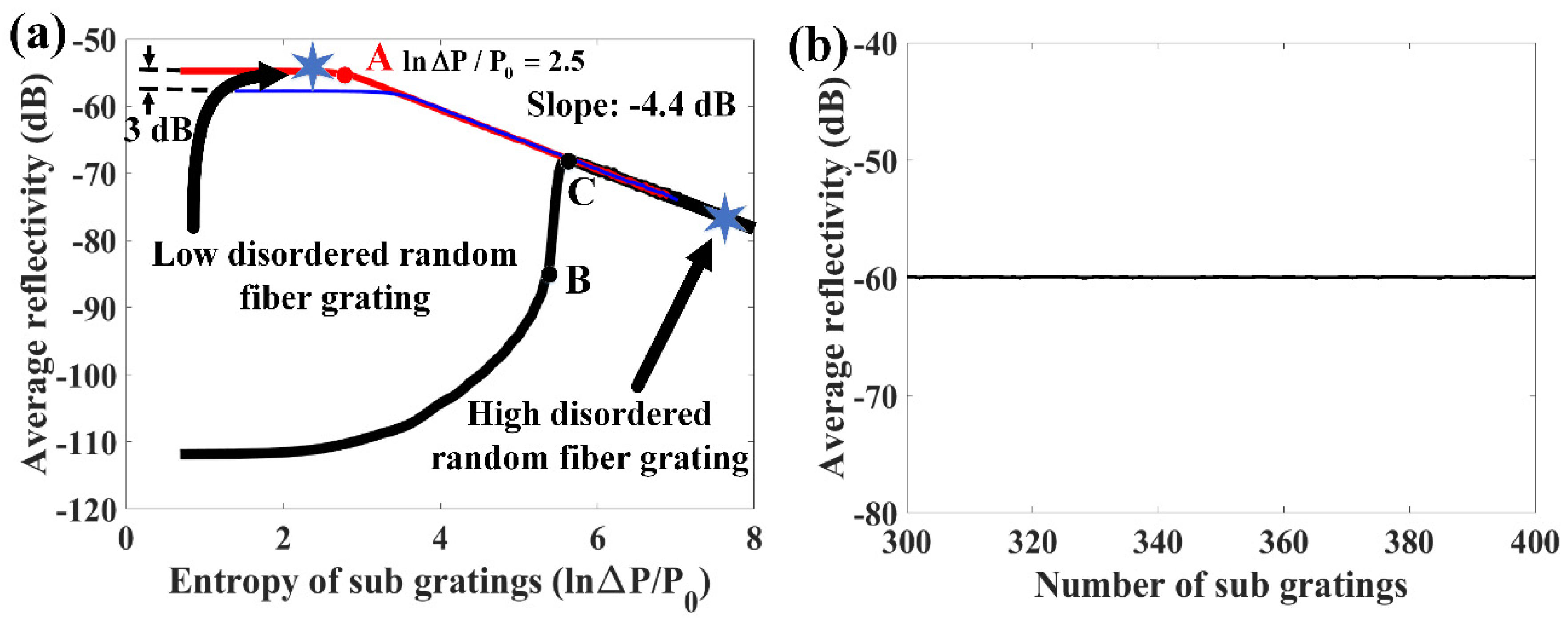
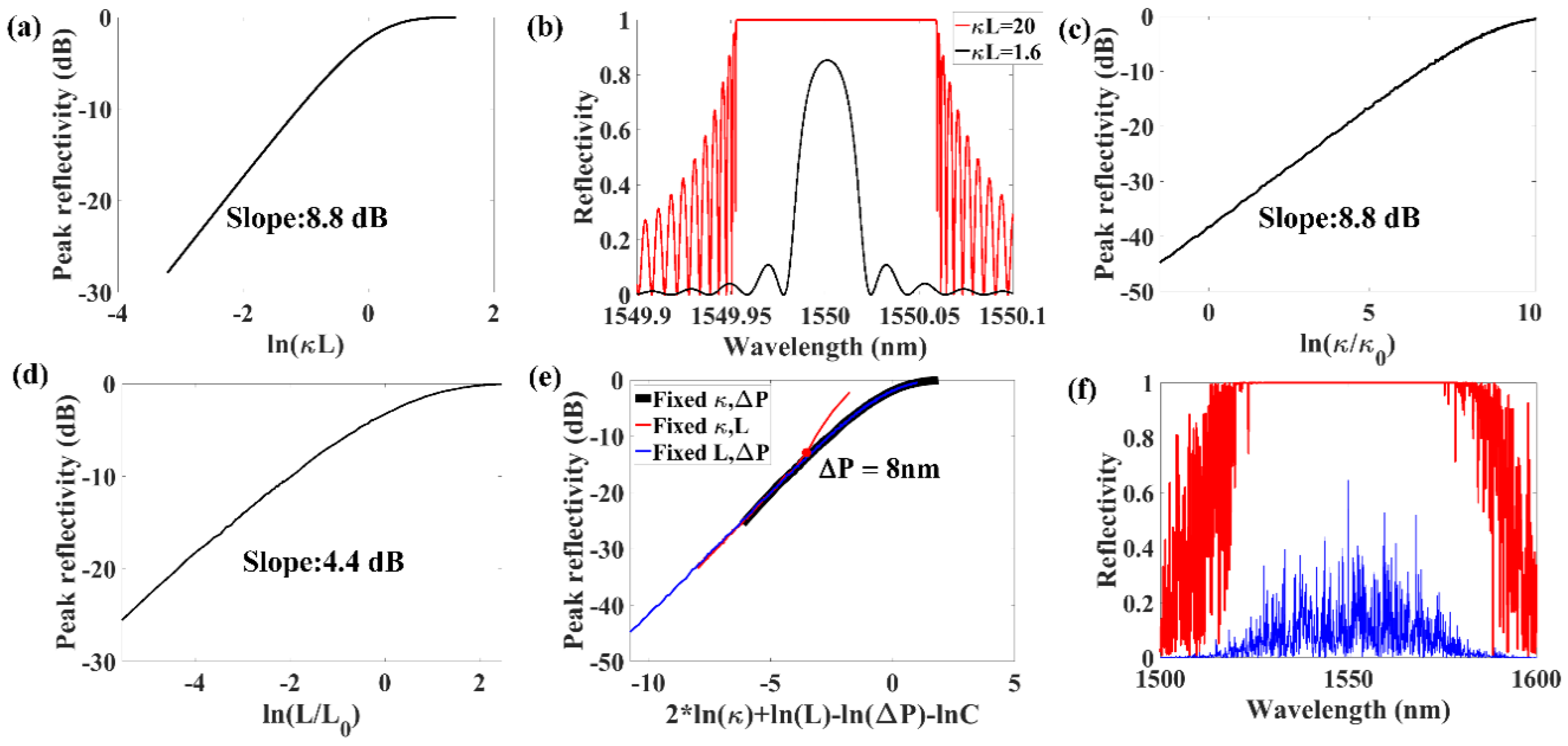
Publisher’s Note: MDPI stays neutral with regard to jurisdictional claims in published maps and institutional affiliations. |
© 2020 by the authors. Licensee MDPI, Basel, Switzerland. This article is an open access article distributed under the terms and conditions of the Creative Commons Attribution (CC BY) license (http://creativecommons.org/licenses/by/4.0/).
Share and Cite
Zhou, Z.; Chen, C.; Lu, P.; Mihailov, S.; Chen, L.; Bao, X. Random Fiber Grating Characterization Based on OFDR and Transfer Matrix Method. Sensors 2020, 20, 6071. https://doi.org/10.3390/s20216071
Zhou Z, Chen C, Lu P, Mihailov S, Chen L, Bao X. Random Fiber Grating Characterization Based on OFDR and Transfer Matrix Method. Sensors. 2020; 20(21):6071. https://doi.org/10.3390/s20216071
Chicago/Turabian StyleZhou, Zichao, Chen Chen, Ping Lu, Stephen Mihailov, Liang Chen, and Xiaoyi Bao. 2020. "Random Fiber Grating Characterization Based on OFDR and Transfer Matrix Method" Sensors 20, no. 21: 6071. https://doi.org/10.3390/s20216071
APA StyleZhou, Z., Chen, C., Lu, P., Mihailov, S., Chen, L., & Bao, X. (2020). Random Fiber Grating Characterization Based on OFDR and Transfer Matrix Method. Sensors, 20(21), 6071. https://doi.org/10.3390/s20216071





